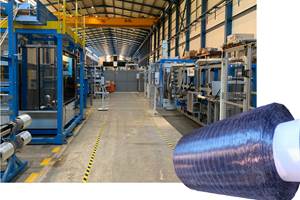AeroLas targets carbon fiber yarn industrialization
Munich-based AeroLas specializes in air-bearing technology and has used it to develop a system that allows for discontinuous carbon fiber to be spun with thermoplastic fibers. Potential applications include 3D printing.
AeroLas GmbH (Munich, Germany) has developed a spinning process by which discontinuous filaments of carbon fiber can be combined with a thermoplastic fiber to create a yarn material that has potential application in additive manufacturing, 3D printing and other composites manufacturing processes.

A traditional ring spinner (right) has a traveler that tends to break carbon fiber filaments. The AeroLas ring spinner (left) features two curved, rounded travelers inside a ring that rotates on air bearing technology. The travelers enable AeroLas to spin yarn using carbon fiber and thermoplastic fiber materials, suitable for use in 3D printing systems. Photo | CW
AeroLas’ technology is a derivative of traditional spinning, which uses a ring spinner (see photo). Michael Muth, executive director at AeroLas, notes that this ring spinner, used to spin 80 percent of the world’s yarn, is incompatible with carbon fiber filaments. The ring’s “traveler,” which guides filaments onto a bobbin (cop) located in the center of the ring, is too sharp and causes carbon fiber filaments to break.
To address this problem, AeroLas turned to air-bearing technology, which the company has developed over several decades for hundreds of industrial applications. An air bearing, as the name implies, replaces traditional metallic bearings with pressurized air to create a gap between two frictional surfaces.
Using this technology, AeroLas rethought the spinning ring to create a ring-within-a-ring design, with pressurized air fed into the gap between the two to facilitate rotation. This design obviates the need for a traditional traveler and allowed AeroLas to switch to a curved, rounded traveler that does not break carbon fiber filaments (see photo and video).
Muth says the company has spent the last few months working with carbon fibers of different lengths, combining it with thermoplastic fibers, to determine optimum fiber length of the spinning process. Preliminary results, he says, indicate that the ideal carbon fiber filament length is about 80 millimeters. The company created a prototype yarn that combined chopped carbon fiber with polyamide 6 (PA6) and offered samples for evaluation by additive manufacturers. Preliminary feedback, says Muth, has been positive. Further, AeroLas took its material to the JEC World 2019 show in Paris (March 12-14) and received strong interest there as well from material suppliers and OEMs.
Muth says that the process can combine technical fiber with any thermoplastic fiber, but the bulk of the company’s work to date has been with carbon fiber. In particular, AeroLas sees its spinning process as an ideal target for recycled carbon fibers. Muth notes that most recycled carbon fibers are converted to a nonwoven format that, although useful, does not take advantage of the mechanical properties available in the fiber.
“Airbus and Boeing have a lot of scrap and they need a solution to bring it into a usable product,” says Muth. “We actually prefer to call it upcycling, as our process preserves the value of carbon fiber by keeping it oriented in the same direction.” Muth also notes that the yarn is flexible and the small bending radius makes it ideal for 3D printing.
The next step for AeroLas, say Muth, is industrialization and commercialization of the spinning technology. Because yarn spinning falls outside the scope of AeroLas’ core business, the goal is to form a new corporate entity, hire engineers and build a production-scale spinning machine. That, however, will require substantial investment, which Muth and his team are currently seeking from interested investors.
For more information, visit www.aerolas.de/en/main/textile_technology.htm or email js@aerolas.de.
Related Content
Infinite Composites: Type V tanks for space, hydrogen, automotive and more
After a decade of proving its linerless, weight-saving composite tanks with NASA and more than 30 aerospace companies, this CryoSphere pioneer is scaling for growth in commercial space and sustainable transportation on Earth.
Read MoreASCEND program update: Designing next-gen, high-rate auto and aerospace composites
GKN Aerospace, McLaren Automotive and U.K.-based partners share goals and progress aiming at high-rate, Industry 4.0-enabled, sustainable materials and processes.
Read MoreCryo-compressed hydrogen, the best solution for storage and refueling stations?
Cryomotive’s CRYOGAS solution claims the highest storage density, lowest refueling cost and widest operating range without H2 losses while using one-fifth the carbon fiber required in compressed gas tanks.
Read MoreNovel dry tape for liquid molded composites
MTorres seeks to enable next-gen aircraft and open new markets for composites with low-cost, high-permeability tapes and versatile, high-speed production lines.
Read MoreRead Next
Modeling and characterization of crushable composite structures
How the predictive tool “CZone” is applied to simulate the axial crushing response of composites, providing valuable insights into their use for motorsport applications.
Read MoreCFRP planing head: 50% less mass, 1.5 times faster rotation
Novel, modular design minimizes weight for high-precision cutting tools with faster production speeds.
Read MorePlant tour: A&P, Cincinnati, OH
A&P has made a name for itself as a braider, but the depth and breadth of its technical aptitude comes into sharp focus with a peek behind usually closed doors.
Read More

















.jpg;maxWidth=300;quality=90)








